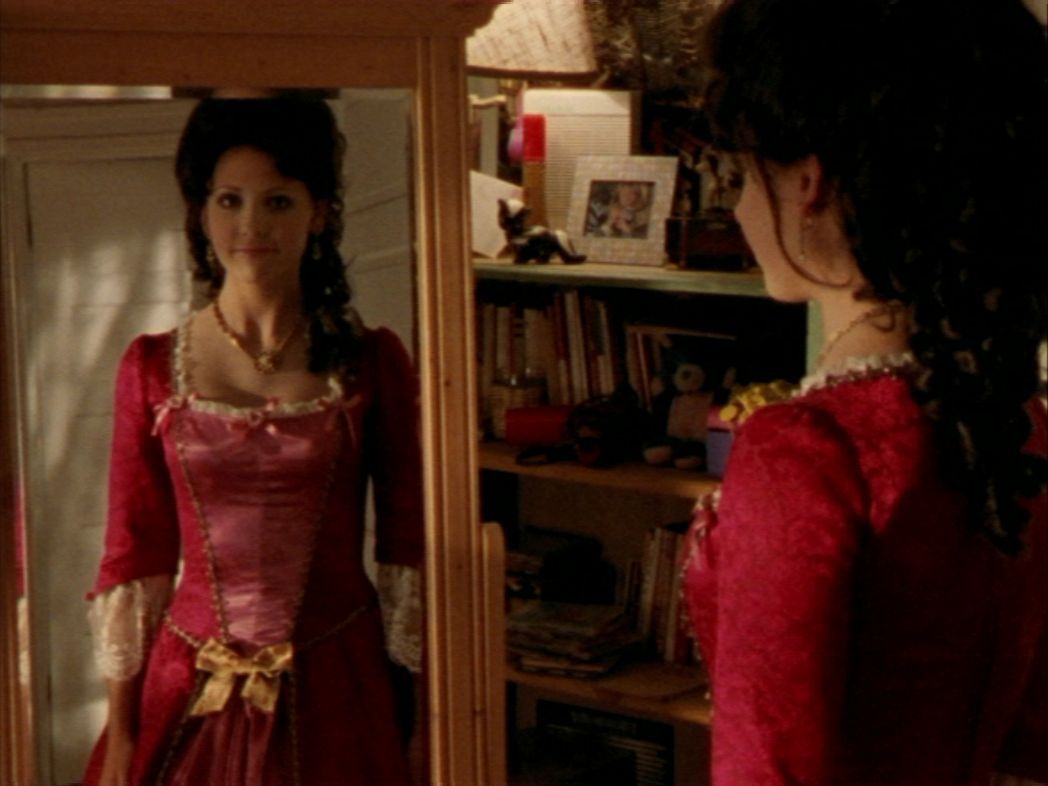
'Halloween' is another classic comedy Buffy episode (and no one ever seems concerned that Willow is technically dead for most of the story - she certainly doesn't have Buffy's level of angst about it). The concept (everyone turns into the people they're dressed as) has loads of potential and Buffy as a helpless eighteenth century noblewoman is very amusing, though it's a shame the dress is such a hideous shade of bright pink - someone really needs to tell costume designers that getting an action-oriented character into a girly dress doesn't mean said dress has to be pinker than candyfloss (see also an episode of Firefly whose title I can't remember and, to a lesser extent, Hermione's dress in Goblet of Fire). This is also the episode that establishes that vampires and nasties supposedly stay home on Halloween and gives us lots of Cordelia flirting with Angel, so we can all enjoy the irony of Willow's attempts to assure Buffy that Angel would never go for Cordelia.
The reason everyone turns into their costumes is that the shop-owner, Ethan, has performed some kind of spell or ritual. Ethan, an old 'friend' of Giles's, apparently worships chaos and wanted to create, well, a chaotic situation. To perform his rituals, the words for which are, of course, in Latin, Ethan kneels in front of a double-faced bust that apparently represents Janus, a Roman god (whose name Ethan correctly pronounces 'Yanus', as the Latin word is 'Ianus').
Giles claims Janus stands for 'the division of self, male and female, light and dark'. Which, er, he doesn't. But it does go very well with the theme of the episode, in which we see the tougher (and more chivalrous) side of Xander, the weaker side of Buffy, the sexy side of Willow and the Dark Side of Giles - an excellent plot development that stopped Giles from being a tweed-wearing, tea drinking walking stereotype and gave us the sublime 'Band Candy' in season three.
Janus was the god of doors and gateways and, like a door, looked both ways, hence the double head. He was also a god of beginnings, which is why he gives his name to January, the first month of the year. He stands, not so much for division, as for liminal spaces, that is, places or situations that exist on the borders, neither one thing nor the other. He is usually, though not always, depicted with two identical, often bearded faces. Ethan's bust is a bit different, with one plain and serious face and one bearded face which is modelled after 'comedy' masks from ancient theatre, so the whole effect essentially plays on the well known modern juxtaposition of comic and tragic masks. This is an unusal way to depict Janus, but it works very well for the episode's theme and the comic mask is nicely creepy and provides a more
 interesting look for the prop than a standard Janus bust would. (Greek theatrical masks are seriously creepy, especially the comic ones, how anyone sat through plays looking at them I don't know!)
interesting look for the prop than a standard Janus bust would. (Greek theatrical masks are seriously creepy, especially the comic ones, how anyone sat through plays looking at them I don't know!)Ethan's fantastically creepy Janus
Gates and especially doorways seem to have been used in Roman magic spells; certainly, the witches in poetry (who may or may not have anything in common with real magical practices) often refer to liminal places like cross-roads (Theocritus' Idyll 2) or doorways in their spells. So Janus is a fairly logical god to attach to a magic spell. He doesn't, however, have anything to do with Chaos. Chaos, parent of Night among others, was an important part of creation mythology, but not connected with regular worship or cult practices. If you were looking for an ancient deity to worship as the embodiment of chaos, well, there isn't one, but you'd be closer with Bacchus or Cybele.
'Halloween' is a brilliant episode, hilarious and sweet as all the best comedy episodes are (plus it's the introduction of Ripper Giles!). It ends with Ethan's ominous note, 'Be seeing you,' which is presumably a reference to classic British TV series The Prisoner, and suitably creepy. The episode's use of Janus is also very effective. Although the nature of the god has been altered somewhat from Roman mythology, the use of the double-faced god as a symbol of the division of self does work rather well and the use of the theatrical masks for his faces is a stroke of genius. The episode's emphasis on their incarnation of Janus as a symbol of one divided being does rather lose the emphasis on looking both forward and backward that gives the month of January its name, but having been transposed to Halloween, it works rather well, bringing out hidden aspects of the regular characters just as the mythology of Halloween suggests that the night brings hidden things, always present but not usually seen, out of the darkness.

If you're in the mood for more spooky-type classical references, here are some more Halloween-y posts from the archives:
Neil Gaiman's The Graveyard Book and Stardust
The Mummy (1999)
True Blood season two
Charmed, 'Oh my goddess!'
Satanic sit-com Old Harry's Game
Other Buffy and Angel posts: Giles the Classicist, 'Storyteller', 'Restless', Angel's Oracles, 'Bewitched, Bothered and Bewildered'
Harry Potter posts: Books 1-3, Books 4-5, Philosopher's Stone, Chamber of Secrets, Half-Blood Prince
One of Chris Riddell's beautiful illustrations from The Graveyard Book




No comments:
Post a Comment